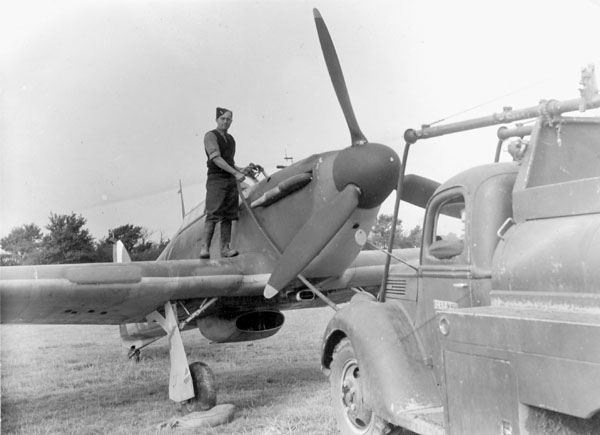Friday 22 August 1941
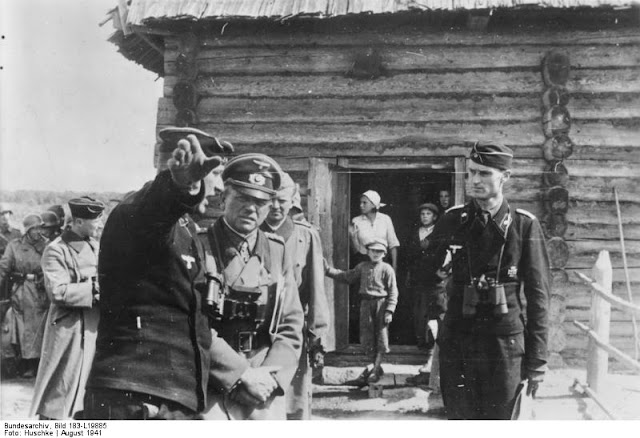 |
| General Heinz Guderian at a forward headquarters of a panzer unit, August 1941 (Huschke, Federal Archive, Bild 183-L19885). |
The principal objects that must be achieved yet before the onset of winter is not the capture of Moscow but rather, in the South, the occupation of the Crimea and the industrial and coal region of the Donets, together with isolation of the Russian oil regions in the Caucasus and, in the North, the encirclement of Leningrad and junction with the Finns.Field Marshal von Bock, commander of Army Group Center, calls Halder in the afternoon and once again, as he has many times in the past, complains that he must remain on the offensive in order to "maintain his front." However, all across the 2000-mile Eastern Front, the German advance has slowed to a crawl.
 |
| Finnish and Waffen-SS troops heading to the front near Kiestinki on or about 22 August 1941 (sources vary on the date of this photo). Note the soldiers in SS camouflage on the right with Suomi KP-31. |
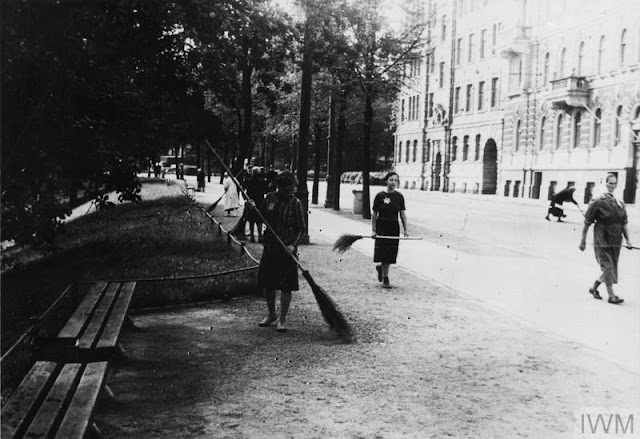 |
| "Jewish women forced to sweep the streets of Riga after its fall to the Germans, 22 August 1941. Note they are already forced to wear Star of David patches on their clothes." © IWM (HU 8966). |
In the Army Group Center sector, there are minor attacks on both sides as the German formations regroup after recent successes. Panzer Group 3 (General Hoth), back in action after refitting, advances toward Velikiye Luki.
In the Army Group South sector, German troops occupy Cherkasy after hard fighting. There also is hard fighting at Dnepropetrovsk. German Sixth Army continues to pursue the retreating Soviet Fifth Army around Kyiv. Panzer Group 1 continues advancing into and occupying the Dneipr bend. Soviet 9th Army and 18th Army withdraw behind the Dneipr River. In an unusual incident, large elements of Soviet 436th Infantry Regiment of 155th Rifle Division deserts to the Germans and is reformed eventually as the Don Cossack unit within the Wehrmacht.
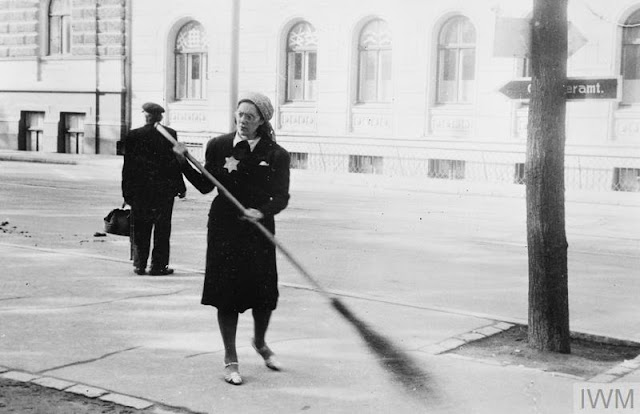 |
| "A Jewish woman forced to sweep the streets of Riga after its fall to the Germans, 22 August 1941. Note she is already forced to wear a Star of David patch on her clothes." © IWM (HU 8967). |
 |
| Irish freighter Clonlara is torpedoed and sunk on 22 August 1941. |
- 484-ton British freighter Empire Oak (13 dead, 8 survivors)
- 1203-ton Irish freighter Clonlara (6 dead, 13 survivors)
U-564 also notifies U-boat command (BdH) of the location of Convoy OG-71, which directs U-201 to the vicinity. In addition, eight Junkers Ju-88 bombers attack, led by (Hptm Heßling), who is killed as a result of the attack.
Royal Navy submarine Trident (Cdr Sladen) torpedoes and sinks 3030-ton German troopship Ostpreußen north of Tromsö in the Kvanangenfjord, Norway.
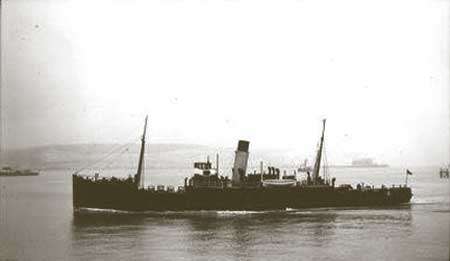 |
| HMS Tonbridge bombed and sunk on 22 August 1941 by the Luftwaffe. |
At Reykjavik, US destroyer USS Charles F. Hughes (DD-428) collides with 5445-ton British freighter Chumleigh and is damaged.
Soviet cargo/liner Pomorie hits a mine and sinks in the White Sea off of Kandalaksha. There are 20 survivors and 60 deaths (accounts vary).
Soviet Submarines D-3 and M-172 (Lt. Cdr. Israel Fisnovich) are on patrol off the coast near Petsamo Fjord. M-172 attempts an attack on German hospital ship Alexander von Humbolde - which would be a war crime under most interpretations of international law - but misses.
After having been damaged by its own torpedoes on 21 August, Free French submarine Rubis gets a message to the Admiralty about its situation. The Admiralty directs several warships to go to its aid off the Norwegian coast.
The government of Brazil seizes 23,861-ton Italian liner Conte Grande at Santos, Brazil. The ship eventually is converted into US troopship USS Monticello (AP-61).
After undergoing repairs in the United States, battleship HMS Rodney departs from Newport, Rhode Island on a working-up cruise.
Royal Navy minesweeper Agamemnon lays minefield SN-22B in the North Sea.
Royal Navy corvette HMS Snowflake and minesweeper Worthing are launched.
Canadian minesweeper HMCS Clayoquot (J-174, Lt. George A. V. Thomson) is commissioned and minesweeper Lockeport is launched.
Australian auxiliary minesweeper HMAS Birchgrove Park is commissioned, destroyer HMAS Derwent is launched.
 |
| German Merchant Ostpreussen torpedoed and sunk by HMS Trident on 22 August 1941 north of Tromsö in the Kvanangenfjord. |
Operation Treacle, the replacement of Australian troops at Tobruk by Polish units of the Carpathian Brigade, continues. Destroyers Hasty, Jervis, and Kimberley and minelaying cruiser Abdiel carry troops successfully to Tobruk and return to Alexandria without incident.
The Luftwaffe bombs Tobruk and damages 1009-ton Greek freighter Lesbos.
Italian 5232-ton tanker Strombo, previously torpedoed in the Zea Channel on 10 July 1941 by Royal Navy submarine Torbay, is completely destroyed in an explosion in Skaramanga Bay.
Royal Navy minelaying cruiser Manxman departs from Gibraltar as part of Operation Mincemeat. Its objective is to lay mines in the Gulf of Genoa in the Livorno area.
Australian destroyer Stuart returns to Australia from Alexandria due to engine problems that require repair. It arrives in Fremantle, Australia on 16 September. Due to its departure, 10th Destroyer Flotilla (known as the "Scrap Iron Flotilla") of the Mediterranean Fleet disbands.
Royal Navy submarine P-33 is reported officially missing at Malta after failing to return from its patrol on 21 August.
RAF Maryland bombers patrol over Lampedusa and attack shore targets, destroying some vehicles.
 |
| Italian transport Lussin, sunk on 22 August 1941 by HMS Upholder. |
Partisans: Repercussions from the assassination in Paris at the Barbes-Rochechouart railway station continue. Otto von Stülpnagel signs a decree stating that any further incidents will result in the reprisal killing of French hostages who have committed any crimes whatsoever.
 |
| A German soldier ties the hands of partisan Franc Sešek of Bukovica prior to being shot by the Germans on Mala Poljana mountain in the Kamnik-Savinja Alps, 22 August 1941. |
US/Japanese Relations: Talks between the Japanese and Germans continue, shielded from both the public and allies. The Japanese Minister of Foreign Affairs informs Ambassador Joseph Grew in Tokyo that the Germans have made inquiries about the nature of the talks. The Japanese tell Grew that they told the Germans that they were simply talking about "specific cases of difficulties experienced by Americans in Japan and China," which is not the case. Grew further notes in a separate wire that the bellicose statements by the United States press about the "encirclement" of Japan by the Allies are having a negative effect on talks.
US Military: The US Marine Detachment, 1st defense Battalion, arrives at Wake Island from Oahu, Hawaii.
Major General Adna R. Chaffee Jr., sometimes called the "Father of the Armored Force, passes away in Boston, Massachusetts of cancer at the age of 56. The M24 Chaffee light tank will be named in his honor, and also Fort Chaffee, Arkansas.
 |
| Italian tanker Strombo, sunk on 22 August 1941. |
Joseph Stalin decrees that Red Army soldiers should receive 100 grams of vodka each per day.
Romanian Military: King Michael promotes Romanian leader Ion Antonescu to the rank of Field Marshal.
Vichy French Military: The third convoy of French troops being repatriated to France departs from Haifa. It carries 4952 troops.
Japanese Military: The Imperial Japanese Navy begins converting 10,383-ton oiler Kuroshio Maru into a warship at Tama Zosen shipyard.
US Military: Thomas Richard Pardue of the 503rd Parachute Infantry Battalion begins the "A" Company Diary. It lasts until 10 November 1945. "Start: 22 August 41. Cpt. Billingalea first Commander of Company “A”, Deavours as 1st Sgt. and company completed by other volunteers."
 |
| Farmers at Tregear Farm, Nanstallon, Cornwall on 22 August 1941. |
American Homefront: In Major League Baseball, the New York Yankees have a 15-game lead over the Chicago White Sox in the American League, while in the National League the Brooklyn Dodgers maintain a one-and-a-half game lead over the St. Louis Cardinals.
Future History: Duane Charles Parcells is born in Englewood, New Jersey. He plays football in college at Colgate University and the University of Wichita (later Wichita State University) and is drafted by the Detroit Lions. However, he does not make the team and goes into coaching instead. As Bill Parcells, he goes on to a top coaching career at the college level and then, beginning in 1979, with the National Football League. Parcells becomes the head coach of the New York Giants, the New England Patriots, the New York Jets, the Dallas Cowboy. Among his other accomplishments, Bill Parcells is the first NFL head coach to guide four different teams to the playoffs. Bill Parcells remains involved with the NFL, and at the time of this writing, he is a courtesy consultant with the Cleveland Browns.
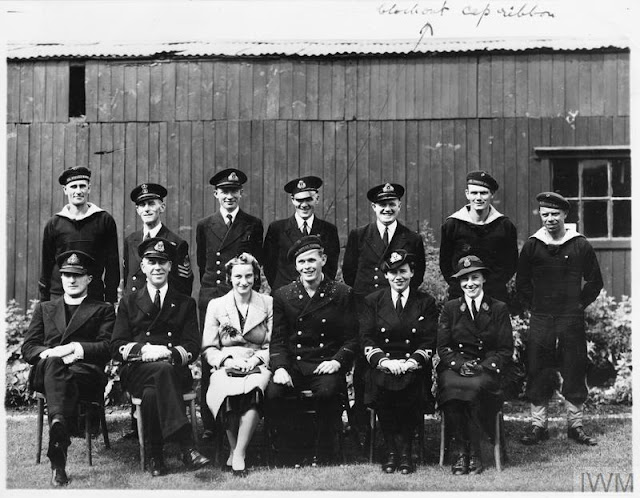 |
| The wedding of Leading Seaman Nils Henry Wiig, RNN, a Norwegian sailor to Miss Ivy May, 22 August 1941 (© IWM (A 5216)). |
August 1941
August 2, 1941: Uman Encirclement Closes
August 3, 1941: Bishop von Galen Denounces Euthanasia
August 4, 1941: Hitler at the Front
August 5, 1941: Soviets Surrender at Smolensk
August 6, 1941: U-Boats in the Arctic
August 7, 1941: Soviets Bomb Berlin
August 8, 1941: Uman Pocket Captured
August 9, 1941: Atlantic Conference at Placentia Bay
August 10, 1941: Soviet Bombers Mauled Over Berlin
August 11, 1941: Rita Hayworth in Life
August 12, 1941: Atlantic Charter Announced
August 13, 1941: The Soybean Car
August 14, 1941: The Anders Army Formed
August 15, 1941: Himmler at Minsk
August 16, 1941: Stalin's Order No. 270
August 17, 1941: Germans in Novgorod
August 18, 1941: Lili Marleen
August 19, 1941: Convoy OG-71 Destruction
August 20, 1941: Siege of Leningrad Begins
August 21, 1941: Stalin Enraged
August 22, 1941: Germans Take Cherkassy
August 23, 1941: Go to Kiev
August 24, 1941: Finns Surround Viipuri
August 25, 1941: Iran Invaded
August 26, 1941: The Bridge Over the Desna
August 27, 1941: Soviets Evacuate Tallinn
August 28, 1941: Evacuating Soviets Savaged
August 29, 1941: Finns take Viipuri
August 30, 1941: Operation Acid
August 31, 1941: Mannerheim Says No
2020

